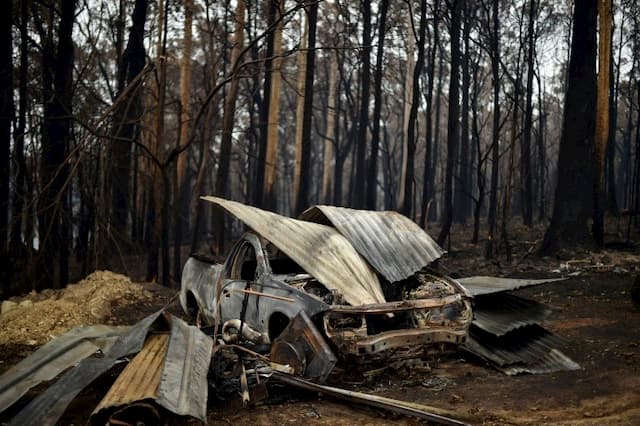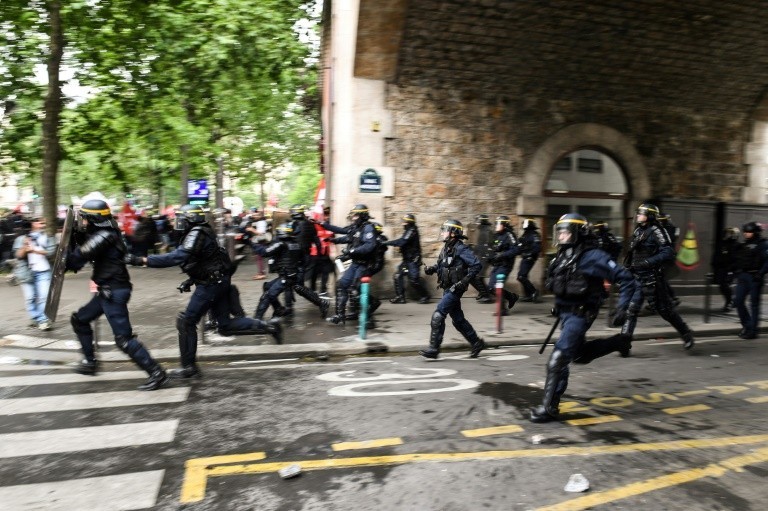Dozens of fires are still out of control in Australia. A further rise in temperatures, accompanied by strong winds, is expected on Friday 10th January 2020.
Firefighters redoubled their efforts Tuesday 7th January 2020 to regain control of gigantic forest fires in Australia, taking advantage of punctually less unfavourable weather before a new heatwave in the coming days.
For these volunteers exhausted after months of fighting against the flames, it was notably a question of channelling the spread of fires, clearing brush at-risk areas or even starting tactical fires to burn the vegetation and deprive the main fires of combustible.
These actions have the appearance of a race against the clock because the weather agency forecasts a further rise in mercury on Friday, accompanied by stronger winds.
“It’s really about organizing protections to limit the potential damage and the appearance of new outbreaks in the coming days,” said the fire chief in rural New South Wales, Shane Fitzsimmons.

Fumes spotted in Argentina
He spoke of conditions now “much more favourable” but warned against “the return of hot weather expected in the week”.
Of dozens of fires still out of control in the east of the vast island continent. And the authorities fear the junction of two raging fires in the states of New South Wales and Victoria, which could give rise to a monumental fire.
Precipitation on Monday offered relative respite but was still insufficient to put out the fires. In some areas, they have even complicated the action of firefighters, in particular, controlled burning operations.
Twenty-five people have died since the start of this crisis in September. More than 1,800 houses have been reduced to ashes, as well as around 80,000 square km, an area equivalent to the island of Ireland.
Another sign of the magnitude of the current disaster, the Chilean and Argentinian meteorological services announced Monday that the smoke from the Australian fires had been spotted in the skies of these two countries, more than 12,000 km from Australia.
It is not yet known what the financial cost of this dramatic fire season, which this time was particularly precocious and virulent, will be. But the Australian Insurers’ Council has announced that claims for compensation received by the companies have already amounted to 700 million Australian dollars (433 million euros), an amount expected to increase.
Cyclone carrying hope
Criticized for the slowness of his response since the start of this crisis, but also for his poor record in the fight against global warming, Conservative Prime Minister Scott Morrison has pledged to donate two billion Australian dollars over two years ( 1.2 billion euros) of tax revenue from a national fund for assistance to fire victims.
In Sydney, a tribute was paid at the funeral to Andrew O’Dwyer, a 36-year-old firefighter who died while fighting fires in late December.
Many of his colleagues in orange uniforms were lined up in the street as the procession passed carrying his coffin which was covered with the flag of the rural fire service.

Conditions in the coming days are not expected to be as dire as last Saturday. But Shane Fitzsimmons told the public broadcaster ABC that one should not “be won over by a false impression of security”.
Many fires are too large to be extinguished by firefighters. And only very significant precipitation will make it possible to overcome it, he said.
Shane Fitzsimmons, who has become the face of the firefighting due to his multiple media interventions, was surprised to welcome the arrival of Cyclone Blake in the northwest of the country , hoping to see the promise of an upcoming end to the fire season.
“It’s good to see that a cyclone is forming. I shouldn’t say that and I hope there will be no damage.”
“With a little luck, it is the sign of the start of the activity linked to the monsoon which will drive out the mass of hot air which influences the weather so much. ”
The first cyclone of the season, Blake swept the city of Broome (northwest) on Tuesday with intense precipitation and gusty winds at 102 km/h.
Broome is more than 3,000 km as the crow flies from Sydney, and the cyclone will have no direct impact on the fires in the southeast. But this first storm of the season in the northwest can be an early warning of the end of the hot and dry conditions that favoured these fires.
In some particularly stricken villages, residents took advantage of the improved weather conditions to return to their homes, while electricity suppliers were starting to restore power in certain localities.
Les feux meurtriers en Australie ont ravagé près de 80.000 km², et décimé la biodiversité.
Mais des images sorties de leur contexte circulent au milieu de clichés authentiques sur les réseaux sociaux.
Tour d’horizon ⬇️https://t.co/Jgwcr5k3KX
🔎@RemiBanet/@ACEFSami#AFP pic.twitter.com/qsOY87fFnm— Agence France-Presse (@afpfr) 7 January 2020




